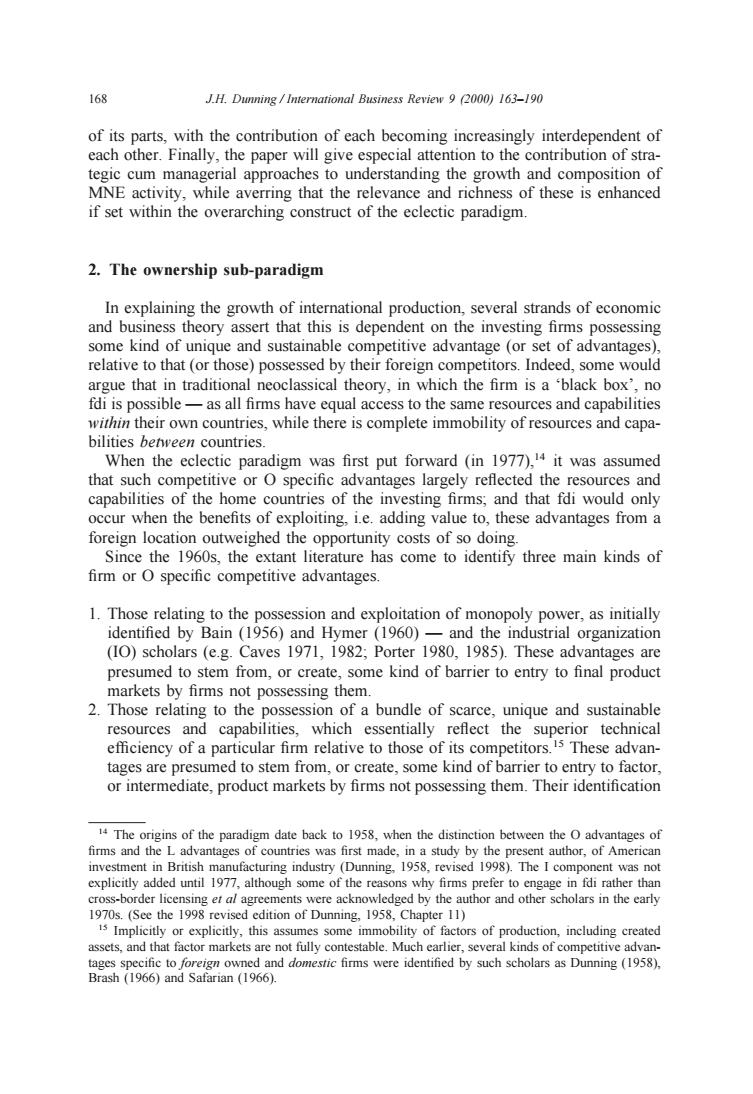正在加载图片...

168 J.H.Dunning/International Business Review 9 2000)163-190 of its parts,with the contribution of each becoming increasingly interdependent of each other.Finally,the paper will give especial attention to the contribution of stra- tegic cum managerial approaches to understanding the growth and composition of MNE activity,while averring that the relevance and richness of these is enhanced if set within the overarching construct of the eclectic paradigm 2.The ownership sub-paradigm In explaining the growth of int several strands of economic and bu as s depe n the inve some nique and sustainab c itive advantage (or advantage relative to t that (or thos e)possessed by their foreign com pettors.Ind some woul argue that in tradition I neoclassical theory,in which the firm is a 'black box',no fdi is possible- as all firms have equal access to the same resources and capabilities within their own countries,while there is complete immobility of resources and capa- bilities berween countries. When the eclectic paradigm was first put forward (in 1977),4 it was assumed that such competitive or o specific advantages largely refected the resources and capabilities of the home countries of the investing firms;and that fdi would only occur when the benefits of exploiting,ie.adding value to,these advantages from a foreign location outweighed the opportunity costs of so doing Since the 1960s.the extant lite ature has come to identify three main kinds of firm or O specific competitive advantages 1.Those relating to the ossession and exploitation of mo power,as initially 1956 (1960 opoly org zatio (IO)scholar aves 197L. 2:P ,198 hese sten n from,or create some kind of barrier to entry to final product 2.Those relating to the possession of a bundle of scarce,unique and susta resources and capabilities,which essentially reflect the superior technical efficiency of a particular firm relative to those of its competitors. These advan- tages are presumed to stem from,or create,some kind of barrier to entry to factor or intermediate,product markets by firms not possessing them.Their identification The origins of the paradigm date back to 1958,when the distinction between the O advantages of irms and th advantages of count was irst made,in study by the author,of America of the reasons why firms p efer to in fdi rather thar der licens g et al agre were acknowledged by the author and other scholars in the early 199 d edition of Dunning. ted assets,and that factor markets are not fully contestable.Much earlier,several kinds of com168 J.H. Dunning / International Business Review 9 (2000) 163–190 of its parts, with the contribution of each becoming increasingly interdependent of each other. Finally, the paper will give especial attention to the contribution of strategic cum managerial approaches to understanding the growth and composition of MNE activity, while averring that the relevance and richness of these is enhanced if set within the overarching construct of the eclectic paradigm. 2. The ownership sub-paradigm In explaining the growth of international production, several strands of economic and business theory assert that this is dependent on the investing firms possessing some kind of unique and sustainable competitive advantage (or set of advantages), relative to that (or those) possessed by their foreign competitors. Indeed, some would argue that in traditional neoclassical theory, in which the firm is a ‘black box’, no fdi is possible — as all firms have equal access to the same resources and capabilities within their own countries, while there is complete immobility of resources and capabilities between countries. When the eclectic paradigm was first put forward (in 1977),14 it was assumed that such competitive or O specific advantages largely reflected the resources and capabilities of the home countries of the investing firms; and that fdi would only occur when the benefits of exploiting, i.e. adding value to, these advantages from a foreign location outweighed the opportunity costs of so doing. Since the 1960s, the extant literature has come to identify three main kinds of firm or O specific competitive advantages. 1. Those relating to the possession and exploitation of monopoly power, as initially identified by Bain (1956) and Hymer (1960) — and the industrial organization (IO) scholars (e.g. Caves 1971, 1982; Porter 1980, 1985). These advantages are presumed to stem from, or create, some kind of barrier to entry to final product markets by firms not possessing them. 2. Those relating to the possession of a bundle of scarce, unique and sustainable resources and capabilities, which essentially reflect the superior technical efficiency of a particular firm relative to those of its competitors.15 These advantages are presumed to stem from, or create, some kind of barrier to entry to factor, or intermediate, product markets by firms not possessing them. Their identification 14 The origins of the paradigm date back to 1958, when the distinction between the O advantages of firms and the L advantages of countries was first made, in a study by the present author, of American investment in British manufacturing industry (Dunning, 1958, revised 1998). The I component was not explicitly added until 1977, although some of the reasons why firms prefer to engage in fdi rather than cross-border licensing et al agreements were acknowledged by the author and other scholars in the early 1970s. (See the 1998 revised edition of Dunning, 1958, Chapter 11) 15 Implicitly or explicitly, this assumes some immobility of factors of production, including created assets, and that factor markets are not fully contestable. Much earlier, several kinds of competitive advantages specific to foreign owned and domestic firms were identified by such scholars as Dunning (1958), Brash (1966) and Safarian (1966)